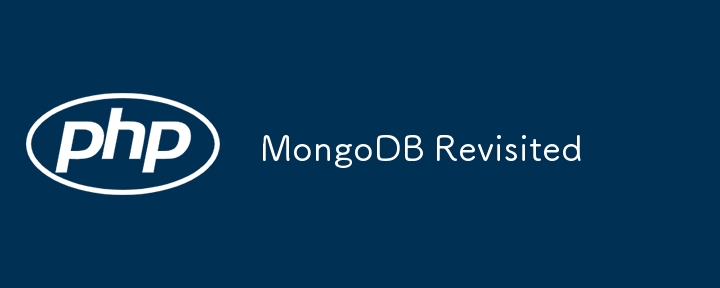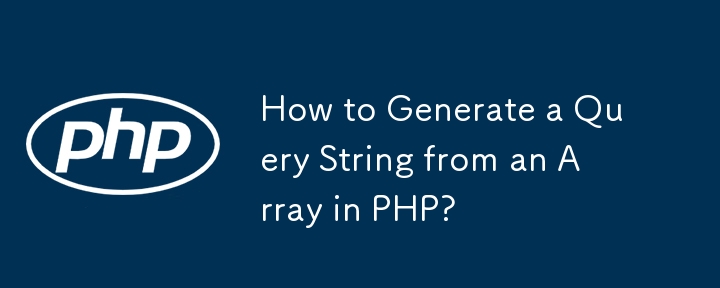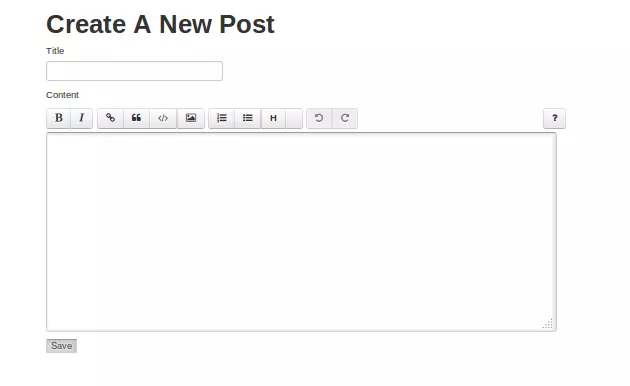Found a total of 10000 related content

MongoDB Revisited
Article Introduction:This article delves deeper into MongoDB, building upon the introductory piece, "Introduction to MongoDB." We'll explore advanced features, including cursors, enhanced query filters, and querying arrays and embedded documents.
Key Concepts:
2025-03-01
comment 0
950



React Query 3: A Guide to Fetching and Managing Data
Article Introduction:Simplify data acquisition for front-end CRUD applications using React Query
Building a front-end CRUD application is easy at first, but as functionality increases, complexity increases rapidly. For each API endpoint, state management, synchronization, caching, and error handling are required. This article will introduce a library called React Query and how it can help solve all of these problems. The library claims to be a "missing data acquisition library" and provides "server state management" for your React application.
We will use a complete React Query demo project to learn the core features that the library provides. You can then apply this knowledge to your own project. First, in
2025-02-10
comment 0
681

Building a Simple Blog App with MongoDB and PHP
Article Introduction:Key Takeaways
MongoDB is a document-oriented NoSQL database that enhances performance and scalability, making it ideal for blog applications where collections and documents can be easily managed.
The PHP MongoDB driver is essential for connectin
2025-02-22
comment 0
1222

MongoDB index optimization strategy to accelerate query performance
Article Introduction:MongoDB index optimization strategy to make your query fly! MongoDB's query speed is slow? Database card into a dog? Don't worry, this article will take you to understand the MongoDB index optimization strategy in an easy-to-understand way, allowing you to completely get rid of the bottleneck of query performance. After reading this article, you can not only master the essence of indexing, but also become a master of MongoDB performance tuning and show off your skills in front of your colleagues! Let’s talk about the conclusion first: the index is like a library directory. Without it, you can only search for information pages by page, which is extremely inefficient; with it, you can quickly locate the target information and query at a high speed! In MongoDB, indexing is just such a thing. It can significantly improve query speed, but improper use can backfire and even reduce performance. Basics:
2025-04-12
comment 0
904

Functional Programming with Phunkie: Parser Combinators in PHP
Article Introduction:Phunkie: Building Parser Combinators in PHP (Part 1)
This tutorial, adapted from the Inviqa blog, demonstrates how to create parser combinators using the Phunkie functional library for PHP. We'll focus on the core concepts and build basic parsers, s
2025-02-10
comment 0
1168

Resize and Manipulate Images in PHP (With Examples)
Article Introduction:This tutorial expands on basic PHP GD library image manipulation, building upon previous coverage of image loading, cropping, rotating, scaling, and flipping. We'll explore advanced techniques like capturing image output streams and embedding waterm
2025-03-03
comment 0
655

Functional Programming with Phunkie: Building a PHP JSON Parser
Article Introduction:This two-part tutorial demonstrates building parser combinators in PHP using the Phunkie functional library. Marcello Duarte, the library's creator, guides you through the process.
This tutorial builds upon basic parser concepts, progressing to mor
2025-02-09
comment 0
857

Fighting Recruiter Spam with PHP - Proof of Concept
Article Introduction:This article details building a custom PHP email processor to manage recruiter spam. It leverages the Fetch library for IMAP interaction and SwiftMailer for automated replies. A scoring system based on keywords and sender information identifies spa
2025-02-10
comment 0
526

Build a React App With a Laravel RESTful Back End: Part 1, Laravel?9 API
Article Introduction:Laravel and React are two popular web development technologies used for building modern web applications. Laravel is prominently a server-side PHP framework, whereas React is a client-side JavaScript library. This tutorial serves as an introduction t
2025-03-01
comment 0
706

How can you interact with NoSQL databases (e.g., MongoDB, Redis) from PHP?
Article Introduction:Yes, PHP can interact with NoSQL databases like MongoDB and Redis through specific extensions or libraries. First, use the MongoDBPHP driver (installed through PECL or Composer) to create client instances and operate databases and collections, supporting insertion, query, aggregation and other operations; second, use the Predis library or phpredis extension to connect to Redis, perform key-value settings and acquisitions, and recommend phpredis for high-performance scenarios, while Predis is convenient for rapid deployment; both are suitable for production environments and are well-documented.
2025-06-19
comment 0
361

Simplify REST API interaction: How to use ogillot/php-restclient library
Article Introduction:When developing a project that requires frequent interaction with external RESTAPI, I encountered a difficult problem: every request requires manually building HTTP requests, handling authentication, header information, parameters, etc., which is huge and error-prone. After trying multiple methods, I discovered the ogillot/php-restclient library, which greatly simplified my work and improved development efficiency.
2025-04-18
comment 0
249

Laravel and Python: Finding the Right Tool
Article Introduction:Laravel is suitable for building web applications quickly, and Python is suitable for projects that require flexibility and versatility. 1) Laravel provides rich features such as ORM and routing, suitable for the PHP ecosystem. 2) Python is known for its concise syntax and a powerful library ecosystem, and is suitable for fields such as web development and data science.
2025-04-18
comment 0
949

Handling character sets and collations issues in MySQL
Article Introduction:Character set and sorting rules issues are common when cross-platform migration or multi-person development, resulting in garbled code or inconsistent query. There are three core solutions: First, check and unify the character set of database, table, and fields to utf8mb4, view through SHOWCREATEDATABASE/TABLE, and modify it with ALTER statement; second, specify the utf8mb4 character set when the client connects, and set it in connection parameters or execute SETNAMES; third, select the sorting rules reasonably, and recommend using utf8mb4_unicode_ci to ensure the accuracy of comparison and sorting, and specify or modify it through ALTER when building the library and table.
2025-07-08
comment 0
526

HTML for Data Visualization Integration
Article Introduction:HTML itself cannot directly realize data visualization, but it can be done as a structural layer basis with other tools. 1. HTML is responsible for building the page skeleton and providing chart containers, such as for SVG or DOM charts, for pixel-level drawing. 2. Implement graphic drawing by introducing libraries such as D3.js, Chart.js or ECharts. For example, initializing a line chart with Chart.js requires introducing scripts and configuring data and styles. 3. Responsive and interactive design can improve experience and performance through CSS media query, window redraw monitoring, library-owned tooltip function and lazy loading mechanism.
2025-07-17
comment 0
675

Solve bottlenecks in big data analysis: Efficient practices of using smi2/phpclickhouse library
Article Introduction:When doing big data analysis, I encountered a common but difficult problem: how to interact with the ClickHouse database efficiently. Traditional database connection and query methods cannot meet the needs of high concurrency and large data volumes, resulting in slow response and even crashes of the program. After some exploration, I found the powerful PHP library of smi2/phpclickhouse, which greatly improved my data processing efficiency.
2025-04-17
comment 0
986

What are collations in MongoDB, and how do they allow for language-specific string comparison?
Article Introduction:Collation is a mechanism used in MongoDB to define string comparison and sorting rules, which directly affects the behavior of query, indexing and sorting in multi-language environments. It determines case sensitivity, accent processing, and the character order of a specific language, such as in Spanish where "ch" is placed between "c" and "d" as an independent letter. 1. It is based on the ICU library and supports complex rules in multiple languages; 2. It can be set at the collection, index or query level to provide flexible configuration; 3. Incorrect settings will lead to inaccurate queries, inconsistent sorting does not meet user expectations, and decreased index efficiency; 4. When using it, you need to pay attention to performance overhead, consistency issues, locale selection accuracy and strength parameter settings. Use colla reasonably
2025-07-03
comment 0
658

Contributing to Open Source: Gatekeeper Case Study
Article Introduction:Contributing to open source projects: A practical case
This article will use a practical case to explain in detail how to contribute code to open source projects. We will take the GateKeeper library as an example to add a counting function and gradually demonstrate the entire process, including communication with the project owner, code implementation, testing, and submitting Pull Request.
Introduction to GateKeeper Library
GateKeeper is a PHP library for user registration, authentication, and authorization. It uses its own database to store and query user records. This makes it completely decoupled from the main application, making it easy to scale and modify.
Add counting function
At present, if GateKeeper wants to obtain the total number of users in the database, it needs to obtain all users first
2025-02-15
comment 0
397

PHP Master | Extract an Excerpt from a WAV File
Article Introduction:While PHP is known for building web pages and applications, it has much more than that. I recently needed to dynamically extract an audio from a WAV file and allow the user to download it through the browser. I tried to find a library that suited my needs, but I didn't succeed and had to write my own code. This is a great opportunity to dig into WAV file structure. In this post, I will briefly outline the WAV file format and explain the library I developed: Audero Wav Extractor.
Key Points
Waveform Audio File Format (WAV) is a standard used by Microsoft to store digital audio data, consisting of blocks representing different parts of an audio file. "RIFF", "Fmt" and "Data" are the heaviest
2025-02-24
comment 0
1117



















